
Sportsmen, land managers and rural homeowners have many tactics for attracting wildlife, especially deer. Oftentimes, they use food to draw deer and other wildlife to their property. Although it’s effective, offering food, especially food that’s not typical to deer’s diet during winter such as deer corn, can be detrimental to their health in more ways than one.
Supplementing a deer’s diet during winter can cause digestive problems, put deer in danger by luring them away from natural wintering spots and increase the risk of chronic wasting disease transmission from feeding in a concentrated area.
Fortunately, there’s a better way to attract deer and ensure they have access to food. Managing woodlots to encourage the growth of woody browse — the main food source of deer during the winter — can attract deer and help maintain your woodlot over time. Learn how to create an ideal forest habitat on your property.
What is browse?
Browse consists of woody vegetation such as young twigs, buds and leaves of trees and shrubs. It is a primary component of a deer’s diet and an important source of nutrition. They feed on browse year-round, but it is especially important during the winter months and early spring when other food sources are unavailable. Additionally, unlike deer corn, browse is easily digested by deer.
Trees and shrubs that provide preferred browse to deer include:
- Blackgum
- Oak
- Basswood
- Maple
- Tulip poplar
- Aspen
- Hickory
- Ash
- Pin cherry
- Dogwood
- Viburnum
- Elderberry
- Hawthorn
- Winterberry
- Sassafras
- Raspberry
- Blackberry
Invasive plant species provide undesirable browse to deer.
How do you increase browse in a woodlot?
One deer will consume a ton of forage annually on average, which means a woodlot must have a lot of preferred browse available to support a single deer and large quantities to support many deer.
There are various ways to increase the browse available to deer in your woods.
Short-term
Cut a tree down. Felled trees provide deer additional browse because deer can access their tender buds and twigs on the ground. Leaving trees lay for a couple of weeks after felling them will allow deer time to consume the browse before they are cleaned up. Additionally, the stump that is left behind will provide more browse in the spring when sprouts begin growing from it.
Long-term
There are various strategies to manage your woodlot long-term to provide plenty of browse for deer.
Felled trees from cutting a single tree down for firewood or to thin an area out can provide additional browse short-term, but to make sure deer have enough browse long-term good woodlot management strategies need to be implemented.
Good management strategies start with an understanding of how much browse different types of woodlots provide. Mature woodlots only produce 50-100 pounds of browse per acre and provide hard and soft mast, such as acorns or nuts. Young woodlots can produce 1,000-2,000 pounds of browse per acre, but little to no mast. Deer need a diverse woodlot with both mature and young areas.
Thin mature woodlots. Enhancing deer habitat and increasing browse can be done by thinning overcrowded trees. Thinning out a woodlot gives the most desirable trees the room they need to grow larger and provides space and sunlight for smaller trees and shrubs to grow on the forest floor. Thinning improves the overall health of the woodlot and by increasing browse and allowing the remaining trees to grow larger with reduced competition for resources.
Regenerate mature woodlots. Another management option is regenerating a mature forest by cutting mature trees and starting a new forest from seedlings and sprouts. This increases the woody browse available as an abundance of herbaceous vegetation and new sprouts are able to flourish with increased sunlight after tree removal.
However, one thing to be aware of is deer can be detrimental to seedlings trying to develop into trees and regrow a woodlot. Where the deer population exceeds the carrying capacity of the habitat, browsing deer can overwhelm young, developing woodlots. So it may be necessary to reduce the deer population prior to attempting a complete forest regeneration.
Forest and wildlife professionals can help you develop the best plan to enhance browse on your woodlots. Contact your local soil and water conservation district, extension specialists or Ohio Department of Natural Resources office to figure out where to get started.
Related Content
- Feeding deer corn is not the best thing to do
- Feeding corn to deer could be death sentence
- How to establish a wildlife food plot











